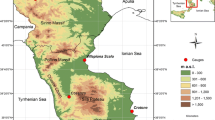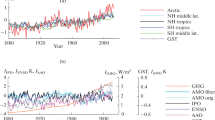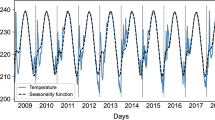Abstract
Customarily, climate studies of long-range temperature variability have been carried out using annual or monthly averages. The approach mixes the details of short- and long-range variability that are different for air temperature series. This work shows that a useful method for eliminating short-range variability on long-range variability is to apply a sufficiently long (about 2 months) time step to the daily series. An autoregressive integrated moving average model is fitted to daily maximum and minimum temperature anomalies from the mean seasonal cycle, using data from a number of Australian and New Zealand weather stations. The fitted model can be considered as a sum of random walk plus white noise. This enables us to obtain a quantitative long-term description of the temperature variability.





Similar content being viewed by others
References
Beran, J. (1994). Statistics for long memory processes. New York: Chapman and Hall.
Box, J. E. P., & Jenkins, G. (1970). Time series analysis, forecasting and control. San Francisco: Holden Day.
Gordon, A. H. (1991). Global warming as a random walk. Journal of Climate, 4, 589–597.
Grieser, J., Trömel, S., & Schönwiese, C.-D. (2002). Statistical Time series decomposition into significant components and application to European temperature. Theoretical and Applied Climatology, 71, 171–183.
Hansen, J., Lacis, A., Ruedy, R., Sato, M., & Wilson, H. (1993). How sensitive is the world’s climate? National Geographic Research Exploration, 9, 142–158.
Hessell, J. W. D. (1979). The use of long time series climatological observations to determine climatic trends. New Zealand Geographer, 35, 80–82.
Hessell, J. W. D. (1980). Apparent trends of mean temperature in New Zealand since 1930. New Zealand Journal of Science, 23, 1–9.
Kane, R. P., & Teixeira, N. R. (1990). Power spectrum analysis of the time series of annual mean surface air temperatures. Climatic Change, 17, 121–130.
Kärner, O. (2005). Some examples on negative feedback in the Earth climate system, Central European. Journal of Physics, 3, 190–208.
Kärner, O. (2009). ARIMA representation for daily solar irradiance and surface air temperature time series. Journal of Atmospheric and Solar-Terrestrial Physics, 71, 841–847.
Ladoy, Ph., Lovejoy, S., & Schertzer, D. (1991). Extreme variability of climatological data: Scaling and intermittency. In D. Schertzer, & S. Lovejoy (Eds.), Non-linear variability in geophysics (pp. 241–250). Dordrecht: Kluwer.
Lovejoy, S., & Schertzer, D. (1986). Scale invariance in climatological temperatures and the local spectral plateau. Annals of Geophysics, 4B, 401–410.
Mandelbrot, B. B. (1982). The fractal geometry of nature. New York: Freeman
Mills, T. C. (2007). Time series modeling of two millennia of northern hemisphere temperatures: Long memory or shifting trends. Journal of the Royal Statistical Society. Series A, 170(1), 83–94.
Monin, A. S., & Yaglom, A. M. (1975). Statistical fluid mechanics (Vol. 2). Boston: MIT.
North, G. R., & Cahalan, R. F. (1981). Predictability in a solvable stochastic climate model. Journal of the Atmospheric Sciences, 38, 504–513.
Taqqu, M. S., & Teverovsky, V. (1998). On estimating the intensity of long-range dependence in finite and infinite variance time series. In R. Adler, R. Feldman, & M. S. Taqqu (Eds.), A practical guide to heavy tails: Statistical techniques and applications (pp. 177–217). Boston: Birkhauser.
Taylor, G. I. (1935). Statistical theory of turbulence, parts I to IV. Proceedings of the Royal Society of London, A151, 421–478.
Withers, C. S., Krouse, D. P., Pearson, C. P., & Nadarajah, S. (2009). Modelling temperature trends in New Zealand. Environmental Modeling & Assessment, 14, 231–249.
Zheng, X., & Basher, R. E. (1998). Structural time series models and trend detection in global and regional temperature series. Journal of Climate, 12, 2347–2358.
Author information
Authors and Affiliations
Corresponding author
Rights and permissions
About this article
Cite this article
Kärner, O., de Freitas, C.R. Modelling Long-Term Variability in Daily Air Temperature Time Series for Southern Hemisphere Stations. Environ Model Assess 17, 221–229 (2012). https://doi.org/10.1007/s10666-011-9269-z
Received:
Accepted:
Published:
Issue Date:
DOI: https://doi.org/10.1007/s10666-011-9269-z




